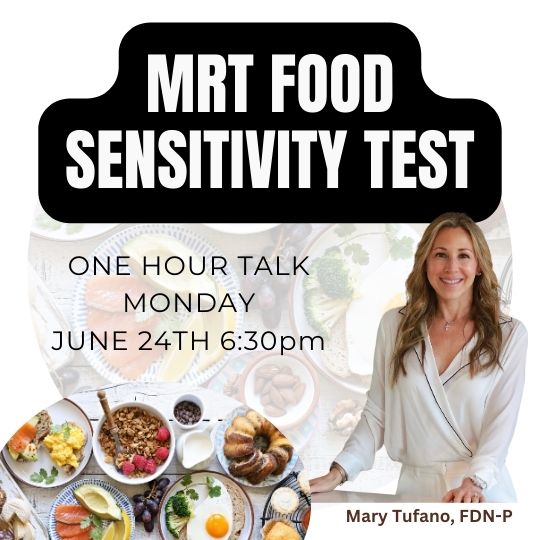
“Food Sensitivities (not to be confused with food allergies) can cause a whole host of symptoms. They are immune responses to specific foods that can trigger reactions in the body.”
- Mary Tufano

Is Food Making You Sick?
Food is one of the most important basic necessities of life! Food is what gathers families around the dinner table every night. It makes holiday memories and celebrations special. But what if the food you are eating is making you sick?
Food contains nutrients that are essential to the growth, repair, and maintenance of our bodies. They provide the energy our bodies need to function on a daily basis. Yet choosing the wrong foods for our system can sabotage our health in ways we can’t even imagine.
Food Sensitivities (not to be confused with food allergies) can cause a whole host of symptoms. They are immune responses to specific foods that can trigger reactions in the body. But when symptoms go unresolved and are simply treated at the surface level, they will continue to repeat the following day, creating an endless cycle of problems.
What are the symptoms of food sensitivities?
Symptoms and conditions that may be related to food sensitivities include:
- Migraines and/or other types of headaches
- Hives, eczema, skin rashes
- Irritable bowel syndrome (IBS), heartburn, and other gastrointestinal issues
- Bloating or diarrhea
- Acid reflux
- Brain fog
- Fatigue, irritability, anxiety, and other mood disorders
- Fibromyalgia
- Joint or muscle pain
- Congestion or respiratory conditions
- Behavioral issues, such as anger, aggression, hyperactivity, or attention deficit disorder (ADD)
Are food sensitivities and food allergies the same thing?
No, food sensitivities differ from food allergies and food intolerances in several ways.
Food Allergies:
- Directly involve the immune system.
- Occur when the body produces Immunoglobulin E (IgE) – antibodies produced by the body’s immune system – in response to a food, which triggers the release of histamine and pro-inflammatory compounds.
- Result in an anaphylactic, potentially life-threatening response.
- Occur quickly, typically within minutes to hours.
- Examples include allergies to peanuts and shellfish.
Food Intolerances:
- Do not involve the immune system.
- The body cannot properly process or digest specific foods.
- An example is lactose intolerance.
Food Sensitivities:
- Involve the immune system, like food allergies, but through different pathways.
- Pro-inflammatory chemicals called “mediators” are released into the bloodstream in response to specific foods or chemicals, resulting in uncomfortable symptoms.
- Delayed or dose-dependent response.
- Examples include soy, corn, eggs, and gluten.
What is a food sensitivity test?
Food sensitivity tests identify specific foods or food chemicals that cause inflammatory responses within the body. When our body encounters one of these foods or chemicals, our immune system triggers the release of pro-inflammatory chemicals, known as “mediators,” that can cause adverse or unpleasant symptoms.
Introducing the MRT Food Sensitivity Test
The MRT Food Sensitivity Test is a patented blood test that identifies our body’s reactions to 147 foods that are commonly found in the average diet. It is considered the highest standard of food sensitivity testing currently available.*
Chemical Sensitivities
In addition to the above, the MRT Food Sensitivity Test tests you for 30 chemicals, including caffeine (yes, caffeine is considered a chemical), Acetaminophen, Ibuprofen, MSG, and many other ingredients found in most beauty and household cleaning products.*
*(Email me if you’d like the full list of foods and chemicals included in the test)
Food Sensitivity Testing is for Everyone!
Unfortunately, millions of people suffer from food sensitivities. Even individuals with extremely healthy eating habits may experience food-related symptoms when those specific foods are inflammatory to their bodies. It can be difficult to pinpoint exactly which foods are triggering our body because symptoms may not appear for hours or days after exposure, and symptoms are often dose-dependent (meaning you can take a couple of bites and be fine but eat the whole thing, and the immune system attacks).
Medications can also mask potentially adverse symptoms, making it challenging to identify the underlying causes of our health issues. Without identifying and addressing food sensitivities, we may delay the healing process and spend significantly more money on unnecessary treatments and medications.
Not only does MRT give insight into inflammation-provoking foods and food chemicals, but more importantly, MRT identifies your BEST foods – the foods that form the basis of a healthy eating plan for you and your body.
How does the testing and diet plan work?
The screening type is a blood test. The tested foods are rated as highly reactive, moderately reactive, low reactive, or non-reactive. A personalized Diet Plan is then generated based on your least reactive foods. The program is implemented over a period of 30 to 60 days, and sometimes longer if a large number of food triggers have been identified. It is a phased approach that allows you to re-introduce foods and/or food chemicals back into your diet over time. This includes foods not tested. When you follow the protocol, you will experience a dramatic improvement in symptoms caused by an immune system reaction.
Phase 1 Elimination Diet
Phase 1 is four weeks in duration. During the first two weeks of this initial phase, you only consume half of the tested, safe “green” foods with the strongest results from your list. During weeks 3 and 4, you consume ALL the foods on your approved green list. The goal this month is to:
- Quickly reduce inflammation.
- Achieve a noticeable reduction in symptoms.
- Create a new baseline for later food re-introduction.
Phase 2 Elimination Diet
Phase 2 is four weeks in duration. This time is spent challenging your reaction to the re-introduction of yellow-tested foods. Any other immune and non-immune responses that might be impacting your health may also be unmasked (e.g., fat malabsorption, IgE allergies, fructose intolerance, etc.). The goal is to identify safer foods.
Phase 3 Elimination Diet
Phase 3 is 30 to 60+ days or longer, as needed. The goal is to continue to expand and “normalize” the diet by challenging any remaining MRT-tested foods, untested foods, or both. As you move forward, the goal is to create a healthy dietary variety to help provide a nutrient-dense diet and a healthy microbiome.
How Much Does the Testing Cost?
The MRT FOOD TEST PACKAGE PRICE is $700. This includes:
-
- Blood draw and travel costs by mobile phlebotomist.
- MRT Food Sensitivity Test for 147 FOODS and 30 FOOD CHEMICALS.
- Two 30-minute follow-up appointments to review test results and
PHASE 1-2-3 of the diet plan for the next two months. The first appointment will be approximately two weeks after the test when the results are received. The second appointment is approximately one month after your first follow-up appointment when you have re-introduced all “safe” foods back into your diet. You will also be given guidance on challenging foods not MRT tested.
For more information about the MRT Food Sensitivity Test, contact Mary Tufano at 631.629.9942 or email marytufano@therootcausesolution.com.
Follow Mary on Instagram and Facebook @therootcausesolution as she shares her personal MRT test results and journey through the 3 Phase Elimination Diet.
Sponsored Links
About The Author

Mary Tufano
Mary Tufano is a Functional Diagnostic Nutrition® Practitioner (FDN-P) and founder of The Root Cause Solution, a full-service diagnostic lab testing company.











